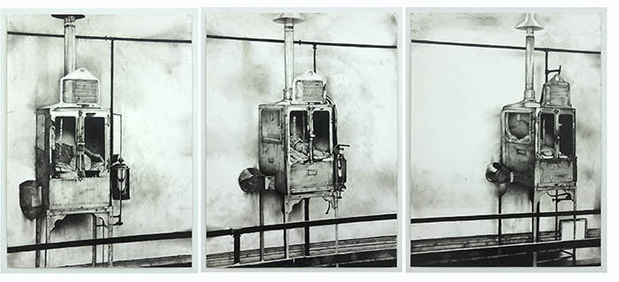Lionel Maunz “Fealty”
Bureau

[Images: Lionel Maunz "Obligation 1, Obligation 2, Obligation 3" (2016) Graphite on paper 30 x 22 inches, each]
This event has ended.
Bureau presents Fealty, Lionel Maunz’s fourth solo show with the gallery. The exhibition comprises three large and intricate sculptures in iron, concrete and steel as well as several new graphite drawings. In his most direct work to date, figurative forms are degraded and mutilated, manifesting Maunz’s aesthetics of destructive will, while exposing the corrupting agents of desire and need. Through this work, Maunz dissects the litany of cruel theories of child rearing developed during the 20th century, focusing on the work of Harry Harlow and R.D. Laing.
In the main gallery Maunz’s major work Mother My Body Disgusts Me addresses the corruption of the family unit head-on. A multi-tiered complex of cast concrete architecture commands the space, atop which sit ruinous mother and father figures in cast iron. Their bodies, like effigies, appear to be deteriorating, hollowed out and undulating with decay. Grave-like cavities within the barren, concrete construction reveal various depictions of the child: atomized, amputated, bound, idealized. The drawing New Mother shows a grisly female torso with an empty cavity in place of a belly: her womb – like the innards of the cast iron mother – offers haven to a foreboding wasp nest.
A trio of stark drawings hangs nearby depicting isolation chambers. These sterile incubators, devised at a time when pathogens were first discovered as the vector of disease, defined the standard for protecting infants’ environs in the early 20th century. Child hatcheries were implemented as antiseptic chambers to keep infants free from disease-ridden mothers and nurses.
The extreme primate experiments of Harry Harlow beginning in the 1940’s with his famous cloth- and wire-mothers countered the theories of sterile isolation, focused on scientifically elucidating the nature of love. Harlow’s bullish will drove him to extreme lengths; isolating his primate subjects for months, even years, in order to prove his attachment theory. Maunz’s drawing Vertical Chamber shows a desolate enclosure with a small cowering animal in the corner. A shift in perspective at the bottom of the piece shows the same small body, huddled at the depths of a narrowing, inverted pyramid. Harlow’s relentless resolve to work, outside of morality, and without hierarchy, is a crux for Maunz: where the cruel means are of greater importance than the consequent results.
R.D. Laing’s psychiatric theories famously ran counter to the orthodoxy and linked madness to what he saw as the unnatural forces applied by the family unit. He proposed that these primary systems of socialization inflict a crippling influence. As he wrote in 1967, ‘the baby is subjected to these forces of violence, called love, as its mother and father have been, and their parents and their parents before them. These forces are mainly concerned with destroying most of [the child’s] potentialities.’ This transposition of love into violence as Laing describes is an important counterpoint for Maunz’s interest in Harlow: “Harlow drove his monkeys to a despair of infanticide and autophagy. Laing wanted to drive humanity out of their wretched minds so they could see the burden of lies defects and compromises that constituted their ‘sanity’.”
In Maunz’s work we see opposing poles of arrestingly lacerated flesh with cold, sterile lines of logic and machine. His streamlined sculpture, Cleft shows a regimented system of pipes and vessels, bound in a contraption resembling a mechanized body. A machinist interpretation of a brutal birth, rigid and ordered through smooth and sharp edges, this piece complements the carrion-like decay of his figures, with a resolute and assaulting order. In the front gallery Double Bind, his largest cast to date, is a hulking ruinous tangle of human and animal bodies, seething and intertwined around a hard-edged architecture. The equine form with fledgling hooves recalls Maunz’s previous bodies of work while its human counterpart, disfigured and paralytic, underscore the themes of the exhibition.
“I wanted to insert this fundamental spasm into this ugly and exhausted form of the family group,” writes Maunz, “to see if I could torment it back to life, bludgeon it out of history and assumption, and blind tradition into something that bleeds and screams, into something that excites me.”
Lionel Maunz (b. 1976, lives and works in Brooklyn, NY) received his BFA and MFA degrees from the Southern Methodist University in Dallas, TX. His solo project in the lower level at MoMA|PS1 is on view through summer and he will present a solo project this June at Art Basel Statements. In 2017 The Contemporary Austin in Austin, TX will host a solo exhibition of his work. He has been the subject of several one-person exhibitions at Bureau: Deluge, 2014, Receipt of Malice, 2012, and Wail Eternal Scorn of Geologic, 2010. Selected group exhibitions include: Omul Negru, Cantacuzino Palace, Bucharest, Romania (forthcoming); Greater New York, MoMA PS1; Rotrixagatze, On Stellar Rays; ARSC km15.1 simulation, Ramiken Crucible; New Hells, Derek Eller Gallery; and Gallery Loyal, Malmö. In 2009 he was a participating artist in Mirror Me organized by Kai Althoff and Brandon Stosuy at Dispatch, New York. His works are in the permanent collection of the Whitney Museum of American Art.
Media
Schedule
from April 03, 2016 to May 08, 2016
Opening Reception on 2016-04-03 from 18:00 to 20:00